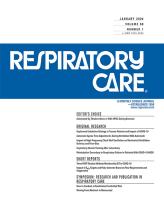This article requires a subscription to view the full text. If you have a subscription you may use the login form below to view the article. Access to this article can also be purchased.
To the Editor:
In their recent publication, Terzi et al1 compared the performance of 4 mechanical insufflation-exsufflation (MI-E) devices under 2 airway conditions: stable upper airway (without collapse) and collapsed upper airway simulated using a Starling resistor. The study focused on evaluating cough peak flow (CPF) and effective cough volume (defined as the volume expired or coughed at a rate > 180 L/s). Their investigation revealed significant performance disparities among the tested MI-E devices. Notably, some demonstrated exceptionally high expiratory flow values > 700 L/min, while others exhibited values < 180 L/min at maximal power. Based on our own experience, drawing from our expertise in this domain, our team was surprised by these findings. Consequently, we decided to replicate the authors' methods for a deeper understanding.
Following Terzi et al1 methodology, we evaluated 3 MI-E devices currently approved for clinical use in France: the CoughAssist E70 (Philips Respironics, Murrysville, Pennsylvania), Comfort Cough II (WILAmed, Kammerstein, Germany), and EOVE-70 (Air Liquide Medical Systems, Antony, France). We were unable to include the …
Correspondence: Marius Lebret PhD, Air Liquide Medical Systems, 6 rue Georges Besse, 92160 Antony, France. E-mail: mariuslebret{at}gmail.com
Pay Per Article - You may access this article (from the computer you are currently using) for 1 day for US$30.00
Regain Access - You can regain access to a recent Pay per Article purchase if your access period has not yet expired.







